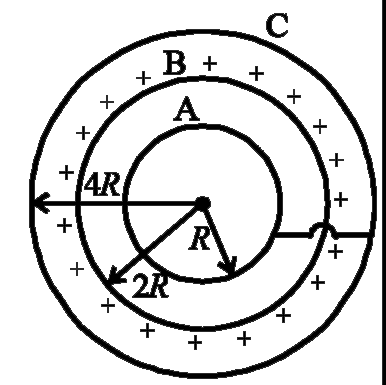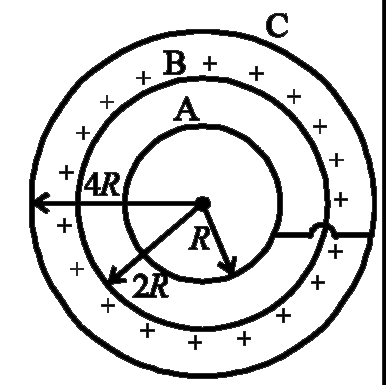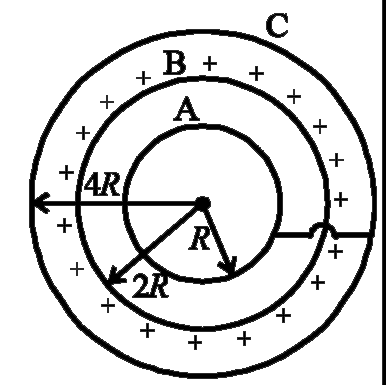Object A, B and C, are three identical, insulated, spherical conductors. Originally, A and B have charges of +3 mC, whereas C has a charge of -6mC. Objects A and C are touched and moved apart, Objects B and C are touched before they moved apart.
(i) If pbjects A and B are now held near each other they will
(a) attract (b) repel (c ) have no effect on each other.
(ii) If instead object A and C held near each other, they will
(a) attract (b) repel (c ) have no effect on each other.
Initially 
* when the object A and C are allowed to touch and then moved aparts,

[+3mC+(−6mC)=−3]−32mC−32mC
* When the object B and C are allowed to touch and then moved apart:

[+3mC+(−32mc)=+32mC]+34mC+34mC
(i) Hence, if A and B are now held near each other. They will attract each other.
(ii) If A and C are now held near each other, they will also attract each other.
Topper's Solved these Questions
- COULOMB LAW AND ELECTRIC FIELDBook:CENGAGE PHYSICSChapter:COULOMB LAW AND ELECTRIC FIELDExercise:Solved examples
Explore 10 Videos
- COULOMB LAW AND ELECTRIC FIELDBook:CENGAGE PHYSICSChapter:COULOMB LAW AND ELECTRIC FIELDExercise:Exercises
Explore 58 Videos
- COMMUNICATION SYSTEMBook:CENGAGE PHYSICSChapter:COMMUNICATION SYSTEMExercise:QUESTION BANK
Explore 19 Videos
- Current ElectricityBook:CENGAGE PHYSICSChapter:Current ElectricityExercise:QUESTION BANK
Explore 40 Videos
Similar Questions
Knowledge Check
An object A has a charge of + 2uC and the object B has a charge of + 6C. Which statements is true ?
AF_(AB) = - 3F_(BA)BF_(AB) = - F_(BA)C3 F_(AB) = - F_(BA)DF_(AB) = 4 F_(BA)An object A has a charge of + 2uC and the object B has a charge of + 6C. Which statements is true ?
AF_(AB) = - 3F_(BA)BF_(AB) = - F_(BA)C3 F_(AB) = - F_(BA)DF_(AB) = 4 F_(BA)Consider three identical metal spheres, A, B and C. Sphere A carries of −2.0μC, spheres B carries a charge of −6.0μC, and spheres C carries a charge of +5.0μC. Sphere A and B are touched together and then separated. Sphere B and C are then touched and separated. Does sphere C end up with an excess or a deficiency of electrons and how many electrons is it ?
Adeficiency, 6×1013Bexcess, 3×1013Cexcess, 2×1013Ddeficiency, 3×1012
Consider three identical metal spheres A,B and C. Spheres A carres charge +6q carries no charge . Spheres A and B are touchd together and them separated. Sphere C is then touched to sphere A and separated from it . Finally the sphere C is touched to sphere B and separated from it . Find the final chage on the sphere C.
View SolutionThree concentric spherical conductors A, B and C of radii R, 2R and 4R respectively. A and C is shorted and B is uniformly charged
Charge on conductor A is

View SolutionThree concentric spherical conductors A, B and C of radii R, 2R and 4R respectively. A and C is shorted and B is uniformly charged .
Potential at B is

View SolutionThree concentric spherical conductors A, B and C of radii R, 2R and 4R respectively. A and C is shorted and B is uniformly charged
Potential at A is

View SolutionYou have two bodies A and B. A is positively charged. If A and B are conductors and A touches B, then
View Solution